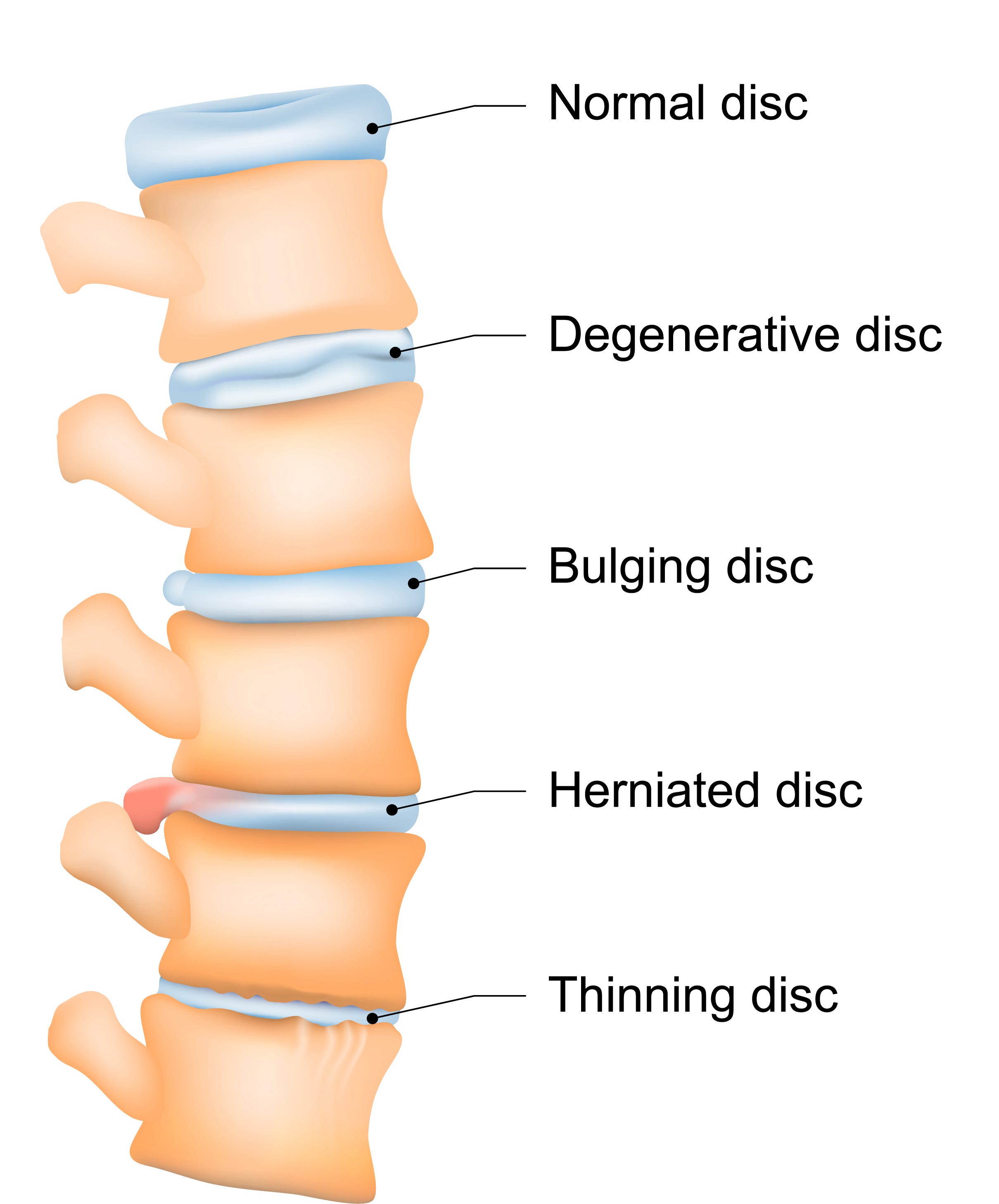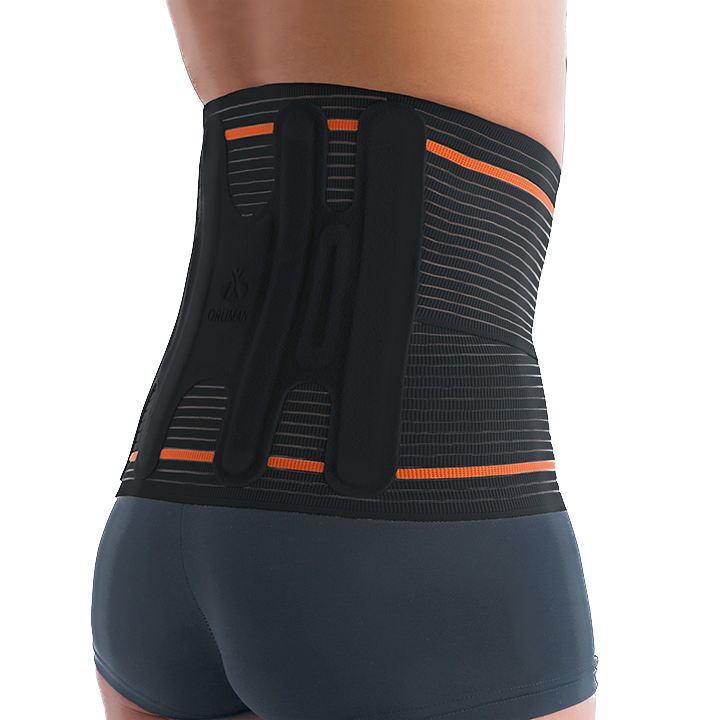What is it?
Lumbar Herniated Disc: Also known as a ruptured disc or slipped disc, this condition happens when the soft inner core of a disc leaks out through a tear in the outer layer of the disc. This leakage can irritate nearby nerves, often causing pain or numbness.
Degenerative Disc Disease (DDD): Despite its name, DDD is not necessarily a "disease" per se. It refers to the natural changes in your spinal discs as you age. These discs act as shock absorbers between the vertebrae of the spine. Over time, they can degrade or wear out, leading to pain and other symptoms.


What causes it?
Several factors can lead a herniated disc or DDD:
Natural Aging: Spinal discs lose flexibility, elasticity, and shock-absorbing capabilities as we age.
Loss of Fluid: Discs can lose fluid, becoming thinner and reducing their cushioning ability.
Micro-cracks: Daily activities and minor injuries can lead to small tears in the disc's outer layer, releasing its jelly-like substance.
Lumbar Herniated Disc: Potential causes encompass:
Aging: Wear and tear with age can predispose discs to herniation.
Physical Strain: Lifting heavy objects using the back instead of the legs can be risky.
Injury: Direct blows or injuries to the spine can initiate herniation.
Symptoms
Symptoms often vary but might overlap:
Pain: Typically in the lower back, but can radiate to the hips and legs.
Numbness or Tingling: Commonly experienced in the legs or feet.
Weakness: Muscles affected by compromised nerves may weaken.
Limited Mobility: Stiffness or restricted movement might be evident.
It's important to note that you may have a degenerative disc disease or a disc herniation and have none of these symptoms!
Stages of Disc Herniation and Disc Degeneration
Here's a simple summary of how some medical books explain the stages of disc problems. This is a basic overview and details might vary in different sources.
Disc Herniation:
Stage 1 (Disc Protrusion): The disc's inner material begins to push out through a small tear in its outer layer, creating a bulge. Pain and discomfort can result if this bulge presses against nearby nerves.
Stage 2 (Disc Extrusion): The inner disc material protrudes further out, extending beyond the perimeter of the vertebrae. The risk of nerve compression increases, leading to more severe pain and potential neurological symptoms.
Stage 3 (Sequestered Disc): A fragment of the disc breaks off from the main disc and can migrate within the spinal canal. This can cause significant nerve compression and is often accompanied by intense pain and neurological deficits.
Disc Degeneration:
Stage 1 (Dysfunction): At this initial stage, there might be minor degeneration with slight annular tears (tears in the outer layer of the disc). Pain may be present, though it is usually intermittent and varies in intensity.
Stage 2 (Dehydration): The disc starts to lose its integrity, leading to a weakened disc structure. There might be occasional pain or discomfort, which may become more persistent.
Stage 3 (Instability): This is a more advanced stage where the disc noticeably narrows and deteriorates. It's accompanied by frequent pain, and the spine may begin to lose stability.
Stage 4 (Stabilization): This is the final stage where there is significant disc narrowing and the formation of bone spurs. The body naturally tries to stabilize the region, leading to reduced mobility. Pain can either decrease as the spine stabilizes or remain consistent.


How a Back Brace Helps with Herniated Disc or Degenerative Disc Disease
- Stabilization: A herniated disc or degenerating disc can lead to instability in the spine. A back brace provides an external support structure that stabilizes the affected spinal segment. This limits excessive or abnormal movements, allowing the area to heal and preventing further injury.
- Reducing Micro-Motions: For someone with DDD or a herniated disc, even the slightest movements (referred to as micro-motions) can exacerbate pain. A brace restricts these tiny motions at the injured or deteriorating segment of the spine, often resulting in immediate pain relief.
- Pressure Redistribution: Back braces are designed to distribute pressure evenly across the lumbar region. This reduces the direct stress on affected discs, helping alleviate pain and discomfort.
- Postural Support: Maintaining the correct posture can be challenging for individuals with DDD or a herniated disc. The brace assists in maintaining an upright posture by supporting the spine's natural curvature. This ensures that no additional strain is placed on the compromised discs.
- Healing Assistance: By limiting the motion and providing stability, back braces create an environment conducive to healing. When the spine is stable, there's less irritation to the nerves, and the body can focus on repairing the damaged or worn-out tissue.
- Pain Management: Pain relief is a direct benefit of wearing a back brace. By immobilizing the affected region, reducing pressure, and supporting posture, a brace can effectively diminish or manage pain, enabling individuals to continue with daily activities with reduced discomfort.
Top Rated Back Braces for Herniated Disc or Degenerative Disc Disease
Best back braces for mild to moderate stages of disc herniation or degeneration
Why we like it
- Low profile construction makes it comfortable to wear
- Elastic straps around the torso provide compression
- Rigid metal stays on the back to resist against forward flexion help protect your movements
Why we like it
- Easy to put on and take off
- Material is very breathable and gentle on the skin
- The degree of stabilization can be adjusted to provide optimal individual support to the lower back
Why we like it
- Has secondary straps to provide further adjustability to the tension of the brace
- Compressive elastic material to enhace posture control
- Budget friendly option
Why we like it
- Precise double-3-point strap system for adjustability to the tension
- Stabilizing back rods and a pullstrap system which increases pressure
- Easy handling due to integrated hand loops
Best back braces for more advanced disc herniation or degeneration
Why we like it
- Rigid panel in addition to stays on the lumbar region for more immobilization of the spine
- Also includes a secondary tension strap
- Breathable train knit
Why we like it
- Very customizable in length
- Material in the brace offers better temperature regulation components for a more comfortable fit
- You can add a heat/ice pack as an add on
We suggest you consult with your doctor to determine what is causing your back pain. Once you know your diagnosis you can contact our Healthcare Team for assistance with selecting the best brace.
If you want to read more about how to select a back brace, check out our other blog post: How to Pick the Right Back Brace + Tips for Proper Use














